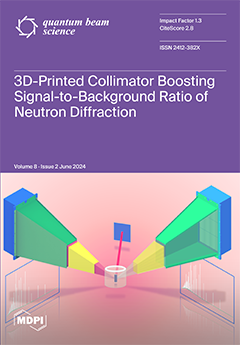We have investigated lattice disordering of cupper oxide (Cu
2O) and copper nitride (Cu
3N) films induced by high- and low-energy ion impact, knowing that the effects of electronic excitation and elastic collision play roles by these ions, respectively. For high-energy
[...] Read more.
We have investigated lattice disordering of cupper oxide (Cu
2O) and copper nitride (Cu
3N) films induced by high- and low-energy ion impact, knowing that the effects of electronic excitation and elastic collision play roles by these ions, respectively. For high-energy ion impact, degradation of X-ray diffraction (XRD) intensity per ion fluence or lattice disordering cross-section (Y
XD) fits to the power-law: Y
XD = (B
XDS
e)
NXD, with S
e and B
XD being the electronic stopping power and a constant. For Cu
2O and Cu
3N, N
XD is obtained to be 2.42 and 1.75, and B
XD is 0.223 and 0.54 (kev/nm)
−1. It appears that for low-energy ion impact, Y
XD is nearly proportional to the nuclear stopping power (S
n). The efficiency of energy deposition, Y
XD/S
e, as well as Y
sp/S
e, is compared with Y
XD/S
n, as well as Y
sp/S
n. The efficiency ratio R
XD = (Y
XD/S
e)/(Y
XD/S
n) is evaluated to be ~0.1 and ~0.2 at S
e = 15 keV/nm for Cu
2O and Cu
3N, meaning that the efficiency of electronic energy deposition is smaller than that of nuclear energy deposition. R
sp = (Y
sp/S
e)/(Y
sp/S
n) is evaluated to be 0.46 for Cu
2O and 0.7 for Cu
3N at S
e = 15 keV/nm.
Full article





